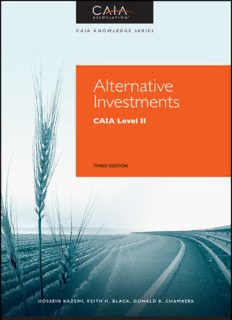
Alternative Investments: CAIA Level II PDF
Preview Alternative Investments: CAIA Level II
Alternative Investments The Wiley Finance series contains books written specifically for finance and invest- ment professionals as well as sophisticated individual investors and their financial advisors. Book topics range from portfolio management to e-commerce, risk man- agement,financialengineering,valuationandfinancialinstrumentanalysis,aswellas muchmore.Foralistofavailabletitles,visitourwebsiteatwww.WileyFinance.com. Founded in 1807, Wiley is the oldest independent publishing company in the United States.With offices in North America,Europe,Australia and Asia,Wiley is globally committed to developing and marketing print and electronic products and servicesforourcustomers’professionalandpersonalknowledgeandunderstanding. Alternative Investments CAIA Level II Third Edition HOSSEIN B. KAZEMI KEITH H. BLACK DONALD R. CHAMBERS Coverimage:©iStock&Shutterstock Coverdesign:ZoeDesignWorks Copyright©2009,2012,2016byTheCAIAAssociation.Allrightsreserved. PublishedbyJohnWiley&Sons,Inc.,Hoboken,NewJersey. PublishedsimultaneouslyinCanada. Nopartofthispublicationmaybereproduced,storedinaretrievalsystem,ortransmittedinanyform orbyanymeans,electronic,mechanical,photocopying,recording,scanning,orotherwise,exceptas permittedunderSection107or108ofthe1976UnitedStatesCopyrightAct,withouteithertheprior writtenpermissionofthePublisher,orauthorizationthroughpaymentoftheappropriateper-copyfeeto theCopyrightClearanceCenter,Inc.,222RosewoodDrive,Danvers,MA01923,(978)750-8400,fax (978)646-8600,orontheWebatwww.copyright.com.RequeststothePublisherforpermissionshould beaddressedtothePermissionsDepartment,JohnWiley&Sons,Inc.,111RiverStreet,Hoboken,NJ 07030,(201)748-6011,fax(201)748-6008,oronlineatwww.wiley.com/go/permissions. LimitofLiability/DisclaimerofWarranty:Whilethepublisherandauthorhaveusedtheirbesteffortsin preparingthisbook,theymakenorepresentationsorwarrantieswithrespecttotheaccuracyor completenessofthecontentsofthisbookandspecificallydisclaimanyimpliedwarrantiesof merchantabilityorfitnessforaparticularpurpose.Nowarrantymaybecreatedorextendedbysales representativesorwrittensalesmaterials.Theadviceandstrategiescontainedhereinmaynotbesuitable foryoursituation.Youshouldconsultwithaprofessionalwhereappropriate.Neitherthepublishernor authorshallbeliableforanylossofprofitoranyothercommercialdamages,includingbutnotlimited tospecial,incidental,consequential,orotherdamages. Forgeneralinformationonourotherproductsandservicesorfortechnicalsupport,pleasecontactour CustomerCareDepartmentwithintheUnitedStatesat(800)762-2974,outsidetheUnitedStatesat (317)572-3993,orfax(317)572-4002. Wileypublishesinavarietyofprintandelectronicformatsandbyprint-on-demand.Somematerial includedwithstandardprintversionsofthisbookmaynotbeincludedine-booksorin print-on-demand.IfthisbookreferstomediasuchasaCDorDVDthatisnotincludedintheversion youpurchased,youmaydownloadthismaterialathttp://booksupport.wiley.com.Formoreinformation aboutWileyproducts,visitwww.wiley.com. ISBN9781119016397(Hardcover) ISBN9781119016366(ePDF) ISBN9781119016380(ePub) PrintedintheUnitedStatesofAmerica. 10 9 8 7 6 5 4 3 2 1 Contents Preface xvii Acknowledgments xxi AbouttheAuthors xxiii PART1 AssetAllocationandInstitutionalInvestors CHAPTER1 AssetAllocationProcessesandtheMean-VarianceModel 3 1.1 ImportanceofAssetAllocation 3 1.2 TheFiveStepsoftheAssetAllocationProcess 6 1.3 AssetOwners 7 1.4 ObjectivesandConstraints 9 1.5 InvestmentPolicyObjectives 9 1.6 InvestmentPolicyConstraints 17 1.7 PreparinganInvestmentPolicyStatement 18 1.8 Implementation 22 1.9 Conclusion 33 Notes 34 References 34 CHAPTER2 TacticalAssetAllocation,Mean-VarianceExtensions,RiskBudgeting,Risk Parity,andFactorInvesting 35 2.1 TacticalAssetAllocation 35 2.2 ExtensionstotheMean-VarianceApproach 45 2.3 RiskBudgeting 50 2.4 RiskParity 55 2.5 FactorInvesting 62 2.6 Conclusion 68 Notes 69 References 69 CHAPTER3 TheEndowmentModel 71 3.1 DefiningEndowmentsandFoundations 71 v vi CONTENTS 3.2 IntergenerationalEquity,Inflation,andSpendingChallenges 74 3.3 TheEndowmentModel 76 3.4 WhyMightLargeEndowmentsOutperform? 78 3.5 RisksoftheEndowmentModel 84 3.6 Conclusion 96 Note 96 References 96 CHAPTER4 PensionFundPortfolioManagement 99 4.1 Development,Motivations,andTypesofPensionPlans 99 4.2 RiskToleranceandAssetAllocation 101 4.3 DefinedBenefitPlans 105 4.4 GovernmentalSocialSecurityPlans 113 4.5 ContrastingDefinedBenefitandContributionPlans 114 4.6 AnnuitiesforRetirementIncome 117 4.7 Conclusion 122 Notes 122 References 122 CHAPTER5 SovereignWealthFunds 125 5.1 SourcesofSovereignWealth 125 5.2 FourTypesofSovereignWealthFunds 128 5.3 EstablishmentandManagementofSovereignWealthFunds 131 5.4 EmergenceofSovereignWealthFunds 134 5.5 GovernanceandPoliticalRisksofSWFs 136 5.6 AnalysisofThreeSovereignWealthFunds 138 5.7 Conclusion 141 Notes 142 References 142 CHAPTER6 TheFamilyOfficeModel 145 6.1 IdentifyingFamilyOffices 145 6.2 Goals,Benefits,andBusinessModelsofFamilyOffices 145 6.3 FamilyOfficeGoalsbyGenerations 150 6.4 MacroeconomicExposuresofFamilyOffices 155 6.5 IncomeTaxesofFamilyOffices 157 6.6 LifestyleAssetsofFamilyOffices 160 6.7 FamilyOfficeGovernance 164 6.8 Charity,Philanthropy,andImpactInvesting 167 6.9 TenCompetitiveAdvantagesofFamilyOffices 170 6.10 Conclusion 172 Notes 172 References 173 Contents vii PART2 PrivateEquity CHAPTER7 PrivateEquityMarketStructure 177 7.1 MainStrategiesofPrivateEquityInvestment 177 7.2 MainDifferencesbetweenVentureCapitalandBuyout 178 7.3 PEFundsasIntermediaries 181 7.4 PEFundsofFundsasIntermediaries 184 7.5 TheRelationshipLifeCyclebetweenLPsandGPs 187 7.6 LimitedPartnershipKeyFeatures 190 7.7 Co-Investments 198 7.8 Conclusion 202 Notes 202 References 203 CHAPTER8 PrivateEquityBenchmarking 205 8.1 TheValuationofPEAssets 206 8.2 MeasuringPerformanceofPEFunds 206 8.3 BenchmarkTypes 212 8.4 Asset-BasedBenchmarks 213 8.5 PeerGroups 215 8.6 WhatIsanAppropriateBenchmark? 218 8.7 ExampleforBenchmarkingPEFunds 220 8.8 PortfolioofPEFunds 226 8.9 Conclusion 231 Notes 232 References 232 CHAPTER9 FundManagerSelectionandMonitoring 235 9.1 PerformancePersistence 235 9.2 ManagerSelectionandDealSourcing 241 9.3 Decision-MakingandCommitment 244 9.4 PrinciplesofFundMonitoring 245 9.5 MonitoringObjectives 246 9.6 InformationGatheringandMonitoring 248 9.7 ActionsResultingfromMonitoring 251 9.8 TheSecondaryMarket 253 9.9 Conclusion 259 Notes 260 References 262 CHAPTER10 PrivateEquityOperationalDueDiligence 265 10.1 TheScopeandImportanceofOperationalDueDiligence 265 viii CONTENTS 10.2 EightCoreElementsoftheOperationalDueDiligenceProcess 268 10.3 PrivateEquityOperationalDueDiligenceDocumentCollection Process 269 10.4 AnalyzingPrivateEquityLegalDocumentationduring OperationalDueDiligence 272 10.5 OperationalDueDiligencebeyondLegalDocumentAnalysis 278 10.6 On-SiteManagerVisits 282 10.7 EvaluatingMetaRisk 284 10.8 FundServiceProviderReviewandConfirmation 285 10.9 OngoingPrivateEquityMonitoringConsiderations 286 10.10 Conclusion 287 Notes 288 ReferencesandFurtherReadings 288 CHAPTER11 PrivateEquityInvestmentProcessandPortfolioManagement 289 11.1 InvestmentProcess 290 11.2 PrivateEquityPortfolio:Design 293 11.3 PrivateEquityPortfolio:Construction 297 11.4 Risk-ReturnManagement 300 11.5 Conclusion 306 Notes 307 References 308 CHAPTER12 MeasuringPrivateEquityRisk 309 12.1 FourSignificantRisksofPrivateEquity 309 12.2 ModelingPrivateEquity 311 12.3 WhatIstheValueofaPrivateEquityAsset? 313 12.4 ApplyingtheVaRConcepttoPrivateEquity 315 12.5 CalculatingVaRBasedonCashFlowatRisk 315 12.6 Conclusion 320 Notes 321 References 321 CHAPTER13 TheManagementofLiquidity 323 13.1 IdentifyingIlliquidityandManagingCashFlows 323 13.2 PrivateEquityCashFlowSchedules 327 13.3 FiveSourcesofLiquidity 328 13.4 InvestmentStrategiesforUndrawnCapital 330 13.5 ModelingCashFlowProjections 330 13.6 ThreeApproachestoFormingModelProjections 331 13.7 Overcommitment 337 13.8 Conclusion 339 Notes 340 References 340
Description: